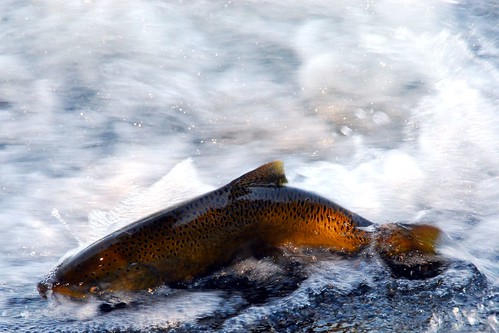
I grew up chasing trout and salmon across the American northeast. From New York to Maine to Canada, the water has always run cold, the pressure ever steady against my legs.
Over the past twenty years, the conditions of my fishing have fluctuated with the weather. Some years were wet, others dry. And yet you always knew the fish were there, if only you could find them.
The fishing became about exploration, and expectation, guided by the certain presence, and beauty, of the fish you chose to chase.
But two reports force a grim question: Will there be a day when I will wade through still waters?
The first report concerns salmon in the San Francisco Bay-Delta area (press release & full report). According to the study, salmon could disappear entirely from California’s rivers, if actions aren’t taken immediately. Water projects in the San Francisco are contributing to declining salmon populations by reducing the water available for spawning; killing tens of thousands of juvenile fish by sucking them into pumps; and by blocking migration routes with dams.
The report comes after a terrible season for California fish stocks. A federal court recently ruled that water projects threaten the survival of several salmon stocks. Earlier this spring, the entire California salmon fishery was closed due to low fish stocks. I wrote about this a few months ago.
The second report concerns trout habitats in the West (press release & full report). This report, called “Trout in Trouble,” describes how Western rivers are getting hotter, and drier. The reduction in cold-water habitat are making it more diffcult for the trout to spawn and to feed and, ultimately, making it much more difficult for them to survive.
As Bruce Farling, executive director of Montana Trout Unlimited (MTU), said: “The implications of our shifting climate are clear: fewer trout and fewer opportunities to fish.”
You’d be right to point out that these are two different fish, in two different areas, confronting two different problems: one is about water management, the other about climate change.
But these two crises share the same two causes: a poor allocation of natural resources, and a failure to learn from past human events. Whether its water, or carbon fuels, our response to increased demand in the face of steady or, in some cases, declining supply, is to invest in improving the supply chain. And yet, we know our own folly. We are dependent, if not addicted, to the very natural resources that are harming our world.
Especially troubling is how slow we are to adopt solutions. Both of these crises could be solved, if only partially, by a combination of federal and state action.
In the West, where the problem is more diffuse, we need legislation that will lead to significant reductions in our carbon emissions, to improved water use, improved shade along riverbanks, and reduced logging roads near riverways. Meanwhile, in California, we need to reduce water diversions and reform water projects.
Growing up, I had the privilege of receiving lessons from Lee Wulff, a famous educator, fly tier and fisherman. In teaching me to respect the fish I longed to catch, my father used to quote Lee Wulff by saying, “fish are too valuable to only be caught once.”
The spirit of preservation could not be more necessary at this moment. Fish are a gift to be nurtured, and to be shared. We should honor them with the national resources, and personal dedication, proportional to the pleasure they bring to us.
On the river, there is no canary, only fish. But in this coalmine economy of ours, our fish are beginning to go belly up, and we have no place to go.
(Photo courtesy of Spappy.jonseS @ flickr, via Creative Commons license.)
Source: Originally published in On Earth on June 27, 2008.
